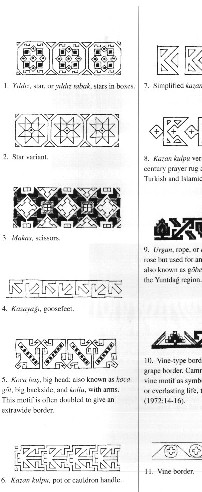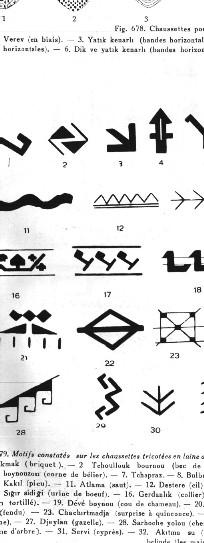| Dear All, Michael may well be right about the origins of the bisected
right angle border motif on the Jaf bag I posted. I am not a weaver, but
would imagine that it is a versatile, basic shape that could be used as a
bracketing/framing device in a field or, as in this case, on its own. I
recently saw it on a NE persian bag on e-bay. It does, however, have some
documentation as a device in the Turkish textile repetoire of devices,
where it is called a "kaz ayagi" or goose-foot. Celal Esat Arseven, in an
early book entitled "Les Arts Decoratifs Turcs" shows it as an old device
used in Anatolian knitted socks, covers, etc. (The book has no publication
date, but probably dates from the late 1920's or early 1930's.) It is also
called a Kaz ayagi in the DOBAG book's list of rug devices. Yusuf Durul,
in a 1974-75 book on Yuruk kilims from the Nigde-Bor region of Anatolia,
illustrates a tribal sign (Im)called a kaz ayagi, only the diagonal
continues through the right angle point to make a Y with a stroke up the
center. Given the simplicity of the form, it may be device that originated
spontaneously in different places or it may have migrated rapidly. But
whatever its origins, it does have its own place in the nomenclature of
Turkish devices. Regards, Kenneth wkthompson@aol.com |
 Even is all these
pieces aren’t of the same quality, comparing their design characteristics,
I have some difficulties to imagine that they all wouldn’t be from the
same group. The Lave/Mendenhall piece (2nd from left) has a knot count of
977/dm² and mine (3rd from left) 1144/dm². These differences aren’t
significant. We may resume their characteristics as follow: 1/ design All
of them have three or four panels in contrasting colors. Brown white brown
being considered as a characteristic by Wendorff or other contrasting
colors as suggested by the comparison of the four pictures.. The first
panel surrounded by contrasting colors (pink, brown, blue, yellow)
contains one powerful brown Memling gull with its center quartered in
various (yellow, blue, orange, pink) colours on a white most often
elongated square hooked ground containing small geometrical devices
(mostly diamonds). The second dark blue or dark brown panel contains top
and bottom a (yellow, pink or orange) crab like, elongated motif and in
each hooks a cross in a square motif. The third white or yellow panel
contains small diamonds in contrasting colors. Some pieces have a fourth
dark blue panel containing the same small diamonds in contrasting colors.
Among other characteristics of this group we may add as Wendorff noticed
it that a pale “suspicious” olive green appears mostly in the borders. 2/
Structure They are floppy and heavy in handle, with a flat back, an
all-wool foundation, and are woven with long pile of silky wool. Knots are
symmetrical and the knot count is around 1000/dm². Warps seems to be in
all of the four pieces white wool. 3/ none of these four pieces has a
closely related palette with the so-called Jaf bag faces, and as Wendorff
proposed it, this may suggest a further North origin. 4/ Comparing these
four pieces mine appears to be the most “Persian” in design. The crab like
design isn’t as elongated as in the other pieces and the “cross in a
square” hooks design of the second panel is replaced in my khorjin by
floral motifs. The color display is also somewhat different. It’s perhaps
for these reasons that Michael suggested that my piece was perhaps woven
near a town. He suggested Rezaiyeh = Urmia (near Lake Urmia in Southern
Kurdistan) as a possible place of origin. Cordially,
Daniel
Even is all these
pieces aren’t of the same quality, comparing their design characteristics,
I have some difficulties to imagine that they all wouldn’t be from the
same group. The Lave/Mendenhall piece (2nd from left) has a knot count of
977/dm² and mine (3rd from left) 1144/dm². These differences aren’t
significant. We may resume their characteristics as follow: 1/ design All
of them have three or four panels in contrasting colors. Brown white brown
being considered as a characteristic by Wendorff or other contrasting
colors as suggested by the comparison of the four pictures.. The first
panel surrounded by contrasting colors (pink, brown, blue, yellow)
contains one powerful brown Memling gull with its center quartered in
various (yellow, blue, orange, pink) colours on a white most often
elongated square hooked ground containing small geometrical devices
(mostly diamonds). The second dark blue or dark brown panel contains top
and bottom a (yellow, pink or orange) crab like, elongated motif and in
each hooks a cross in a square motif. The third white or yellow panel
contains small diamonds in contrasting colors. Some pieces have a fourth
dark blue panel containing the same small diamonds in contrasting colors.
Among other characteristics of this group we may add as Wendorff noticed
it that a pale “suspicious” olive green appears mostly in the borders. 2/
Structure They are floppy and heavy in handle, with a flat back, an
all-wool foundation, and are woven with long pile of silky wool. Knots are
symmetrical and the knot count is around 1000/dm². Warps seems to be in
all of the four pieces white wool. 3/ none of these four pieces has a
closely related palette with the so-called Jaf bag faces, and as Wendorff
proposed it, this may suggest a further North origin. 4/ Comparing these
four pieces mine appears to be the most “Persian” in design. The crab like
design isn’t as elongated as in the other pieces and the “cross in a
square” hooks design of the second panel is replaced in my khorjin by
floral motifs. The color display is also somewhat different. It’s perhaps
for these reasons that Michael suggested that my piece was perhaps woven
near a town. He suggested Rezaiyeh = Urmia (near Lake Urmia in Southern
Kurdistan) as a possible place of origin. Cordially,
Daniel After having read Allan’s post I
looked back to my bagface and noticed a lot of wefts being crossed between
sheds. Look at the wefts two span float at the top
After having read Allan’s post I
looked back to my bagface and noticed a lot of wefts being crossed between
sheds. Look at the wefts two span float at the top Best regards, Giambattista
Best regards, Giambattista




 This Jaf
Kurd bagface, in its present state, is 31 in x 41 in. Flat back, no
depression. Warp: ivory wool, sometimes twisted with brown wool, Z2S; two
weft shots of grey wool, wefts often crossed; 60 symmetric knots/square
inch, with offset knotting in diagonals of lozenges; rich, glossy wool;
floppy but meaty handle. Kilim closure strip, end strip decorated with
small band of complementary weft-weave and brocading. The second photo
shows the checkerboard band at the top. Regards, Kenneth
Thompson
This Jaf
Kurd bagface, in its present state, is 31 in x 41 in. Flat back, no
depression. Warp: ivory wool, sometimes twisted with brown wool, Z2S; two
weft shots of grey wool, wefts often crossed; 60 symmetric knots/square
inch, with offset knotting in diagonals of lozenges; rich, glossy wool;
floppy but meaty handle. Kilim closure strip, end strip decorated with
small band of complementary weft-weave and brocading. The second photo
shows the checkerboard band at the top. Regards, Kenneth
Thompson The Benardout bag is clearly
atypical in every way. The color palette is very different from that of
the other examples (does anyone like it?). The borders are more complex
than on the standard type. Most interestingly, the unusual design element
that appears in red on the Milan bag (just above the central medallion) is
just visible. I don’t know what this means, but the occurence of a bag
with intermediate design might suggest something to someone. Best wishes
Leslie.
The Benardout bag is clearly
atypical in every way. The color palette is very different from that of
the other examples (does anyone like it?). The borders are more complex
than on the standard type. Most interestingly, the unusual design element
that appears in red on the Milan bag (just above the central medallion) is
just visible. I don’t know what this means, but the occurence of a bag
with intermediate design might suggest something to someone. Best wishes
Leslie. I hope this may be useful, best
regards to everybody Giambattista D'Alessio
I hope this may be useful, best
regards to everybody Giambattista D'Alessio